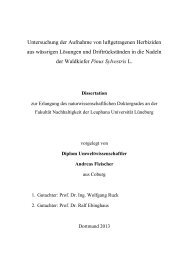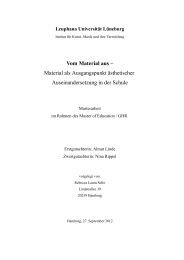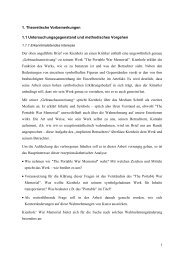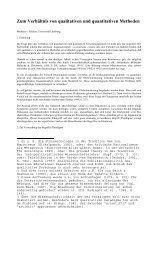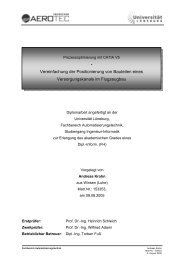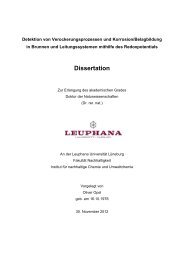Determinants of Emotional Experiences in Traffic Situations ... - OPUS
Determinants of Emotional Experiences in Traffic Situations ... - OPUS
Determinants of Emotional Experiences in Traffic Situations ... - OPUS
You also want an ePaper? Increase the reach of your titles
YUMPU automatically turns print PDFs into web optimized ePapers that Google loves.
49 The <strong>Emotional</strong> Spectrum <strong>in</strong> <strong>Traffic</strong> Situation<br />
The fact that positive emotions were stronger <strong>in</strong> goal congruent situations was only true for<br />
one out <strong>of</strong> three positive feel<strong>in</strong>gs. The means for satisfaction were consistently higher <strong>in</strong> goal<br />
promot<strong>in</strong>g contexts. The different driv<strong>in</strong>g goals <strong>in</strong>fluenced reported levels <strong>of</strong> hope and relief: higher<br />
levels <strong>of</strong> hope were reported <strong>in</strong> arrival situations and the achievement <strong>of</strong> safety-related goals promoted<br />
feel<strong>in</strong>gs <strong>of</strong> relief. This mirrors the nature <strong>of</strong> the relationships between specific situations and emotions:<br />
the <strong>in</strong>tensity <strong>of</strong> hope describes how much someone wants a goal fulfilled (Peterson, 2000). The effect<br />
is even stronger <strong>in</strong> situations where no other driver is to blame (construction site or malfunction<strong>in</strong>g<br />
traffic lights). This might be related to the unfold<strong>in</strong>g <strong>of</strong> events and with what certa<strong>in</strong>ty a specific<br />
outcome (e.g. to pass the construction site) is predicted (Roseman, 1991). Uncontrollable<br />
circumstances could lead to greater hope compared to a situation where the driver has to <strong>in</strong>teract<br />
directly with other traffic participants and their (seem<strong>in</strong>gly) predictable behaviour. But those situations<br />
were both construction sites; other possible contexts (e.g. traffic jams) were not tested <strong>in</strong> this study. A<br />
wider range <strong>of</strong> different situations might trigger different <strong>in</strong>tensities <strong>of</strong> hope. Relief is a result <strong>of</strong> the<br />
successful management <strong>of</strong> a situation <strong>in</strong>volv<strong>in</strong>g tension and uneas<strong>in</strong>ess due to a direct threat (Cors<strong>in</strong>i,<br />
2001). Similar to reported anger, the contrast between the levels <strong>of</strong> goal congruence is relatively small<br />
and even goal block<strong>in</strong>g events (especially safety-related ones like the brak<strong>in</strong>g car or the<br />
malfunction<strong>in</strong>g traffic lights) were able to trigger considerable relief (M = 1.56, SD = 0.87). This<br />
might be due to the nature <strong>of</strong> the described events, which were <strong>in</strong> the worst-case near accidents <strong>in</strong><br />
situations with a safety context. Master<strong>in</strong>g such a situation without experienc<strong>in</strong>g any negative outcome<br />
(such as damage to the car) is the reason described for the relief. Those effects support the need for<br />
stronger goal promot<strong>in</strong>g situations <strong>in</strong> future studies <strong>in</strong> order to elicit variance <strong>of</strong> relief-levels.<br />
The subjects <strong>in</strong> the experiments rated the comb<strong>in</strong>ation <strong>of</strong> goal-<strong>in</strong>congruent, safety goal and<br />
other blame as shown <strong>in</strong> the “brak<strong>in</strong>g car” situation, as elicit<strong>in</strong>g the most emotion. Anger, contempt,<br />
and anxiety on the negative side and surprise and relief on the neutral / positive side <strong>in</strong>dicated a strong<br />
emotional <strong>in</strong>volvement <strong>in</strong> this situation. Out <strong>of</strong> all the situations, this was the most dangerous, because<br />
the driver completely loses and then rega<strong>in</strong>s control <strong>in</strong> a very short time frame. There are no reliable<br />
statistics for how <strong>of</strong>ten such a situation happens on German roads, but almost one quarter <strong>of</strong> all<br />
crashes show similar situational characteristics (e.g. a collision between two cars where one was<br />
beh<strong>in</strong>d the other; Destatis, 2012). Due to the prevalence and emotional <strong>in</strong>tensity <strong>of</strong> this situation, it is<br />
recommended to test it <strong>in</strong> a driv<strong>in</strong>g simulator to assess the possible <strong>in</strong>fluences <strong>of</strong> the emotions which<br />
occur on the driv<strong>in</strong>g behaviour.<br />
The task demand hypothesis could be confirmed: reported levels <strong>of</strong> anger and anxiety were<br />
higher <strong>in</strong> situations with high traffic density and more time pressure. This is concordant to the<br />
literature, where similar effects <strong>in</strong>volv<strong>in</strong>g driver congestion, reported stress and aggressive behaviour<br />
were found dur<strong>in</strong>g rush hour congestion (Hennessy & Wiesenthal, 1999). The results <strong>in</strong> this study<br />
extend the f<strong>in</strong>d<strong>in</strong>gs that satisfaction was significantly lower <strong>in</strong> high task-demand situations. Therefore,<br />
the whole emotional climate is negatively affected by those traffic conditions which are normal for<br />
!



